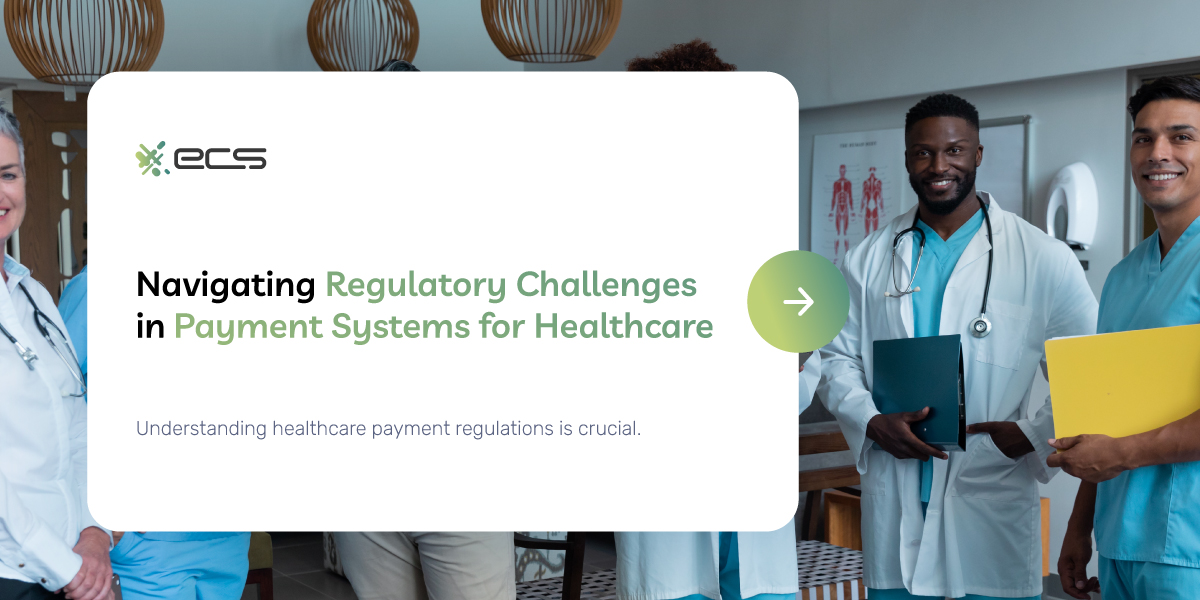Integrating Payment Systems for Healthcare presents unique challenges. Healthcare businesses must deal with a complex regulatory structure involving patient safety, data security, and information management. These relate to payment system data and can create a headache for many healthcare businesses.
Thankfully, with the right solutions and knowledge of payment industry standards, it can be much easier to navigate payment security in the healthcare industry. With the right payment solutions, your healthcare business can realize increased efficiencies, faster payments, and other benefits beyond easier regulatory compliance.
In this guide, we’ll discuss the critical regulatory issues related to healthcare payment systems, including medical billing payment regulations, and the best solutions to help you remain compliant while improving your bottom line.
Understanding The Regulatory Landscape Of Payment Systems for Healthcare
Understanding healthcare payment regulations is crucial. Payment regulations in healthcare span across the federal government, state governments, and even private industry regulations as they relate to payment data security.
Unlike standard transactions, there are further compliance challenges in healthcare payments. Electronic payment systems healthcare compliance regulations must adhere to data security and patient confidentiality. Healthcare businesses must adhere to regulations like HIPAA and HITECH, which the Department of Health and Human Services (HHS) Office for Civil Rights (OCR) is responsible for enforcing the stringent standards for managing patient data and financial transactions.
Secure payment solutions for healthcare are essential. Below are the key areas of healthcare payment compliance.
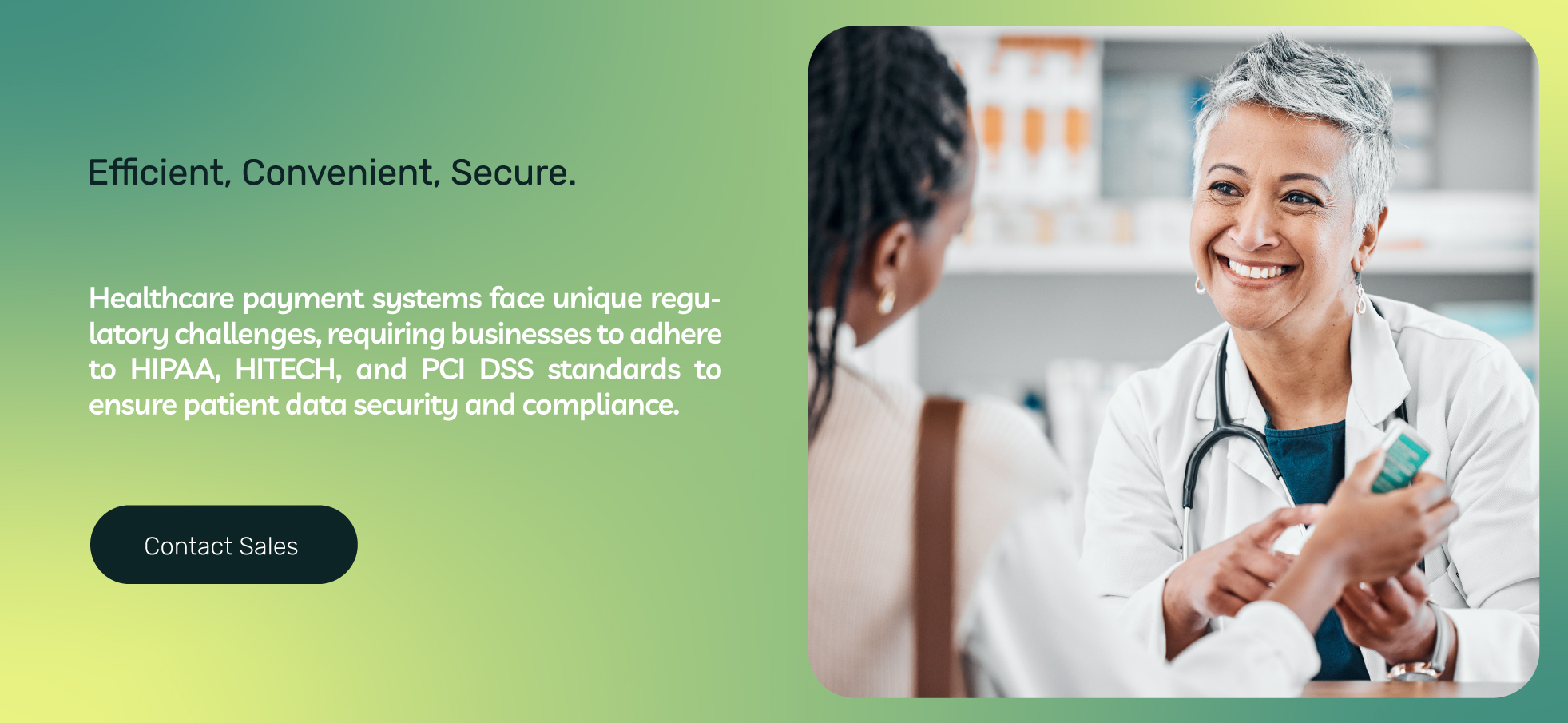
Health Insurance Portability and Accountability Act (HIPAA)
The Health Insurance Portability and Accountability Act (HIPAA) in the United States is a foundational regulation affecting all aspects of healthcare data management, including payment systems. It establishes national standards for the protection of health information, ensuring that patient data is kept confidential and secure during electronic transactions.
HIPAA’s provisions are critical for healthcare providers and payment processors, as non-compliance can result in substantial fines, liability, and legal penalties.
When most healthcare professionals think of HIPAA compliance, they think of patient records. However, payment information related to healthcare services is often integrated with patient information. This information can also contain sensitive treatment information, such as billing codes, diagnostic codes, or other identifiable information that falls under HIPAA regulations.
The result is that your payment system and any integrations you use to connect it to your operational software or databases need to be HIPAA compliant.
The Health Information Technology for Economic and Clinical Health Act (HITECH)
HITECH is mostly designed to improve and update patient care in healthcare facilities around the country. The HITECH Act encouraged the use of technology such as EHRs and other software to improve patient care quality, safety, and efficiency.
Payment regulation impacts on healthcare, particularly through acts like HITECH, also strengthen HIPAA provisions and increase the penalties for HIPAA violations.
However, the HITECH Act also included provisions that strengthened HIPAA provisions and increased the penalties for HIPAA violations.
HITECH also requires that healthcare entities notify any patient of a data breach involving their information within 60 days. That notification must include the nature of the breach, what information was involved, and what is being done to rectify the situation.
Breaches involving 500 patients or more require the healthcare business to notify Health and Human Services (HHS) and also notify a prominent media source where the business is located.
The Payment Card Industry Data Security Standard
The Payment Card Industry Data Security Standard (PCI DSS) is not a government regulation but an industry standard created by the payment industry. It does not directly relate to healthcare businesses but is a standard for all businesses accessing the digital payment network for credit or debit card transactions.
PCI DSS is a set of security standards created to ensure that all businesses that store or transmit credit card data maintain a secure environment. This standard was established by the Payment Card Industry Security Standards Council (PCI SSC), which includes the major credit card brands such as MasterCard, Visa, American Express, Discover, and JCB. PCI DSS protects sensitive cardholder data and prevents fraud and data breaches.
Although PCI DSS is voluntary and carries no legal punishment for non-compliance, a business that is found out of compliance can lose its ability to process credit and debit cards.
In a healthcare setting, following PCI DSS guidelines will help you avoid data breaches and security issues that can lead to federal and state regular compliance issues.
Benefits of PCI DSS Compliance
Achieving PCI DSS compliance provides several benefits:
Enhanced Security: Implementing PCI DSS compliance requirements helps protect sensitive cardholder data from breaches and fraud.
Trust and Reputation: Compliance reassures customers and partners that the organization is committed to maintaining high-security standards.
Avoiding Penalties: Non-compliance can result in significant fines and penalties, as well as higher transaction fees and the potential loss of the ability to process card payments.
Improved Processes: Adopting PCI DSS standards can lead to more efficient and secure business operations.
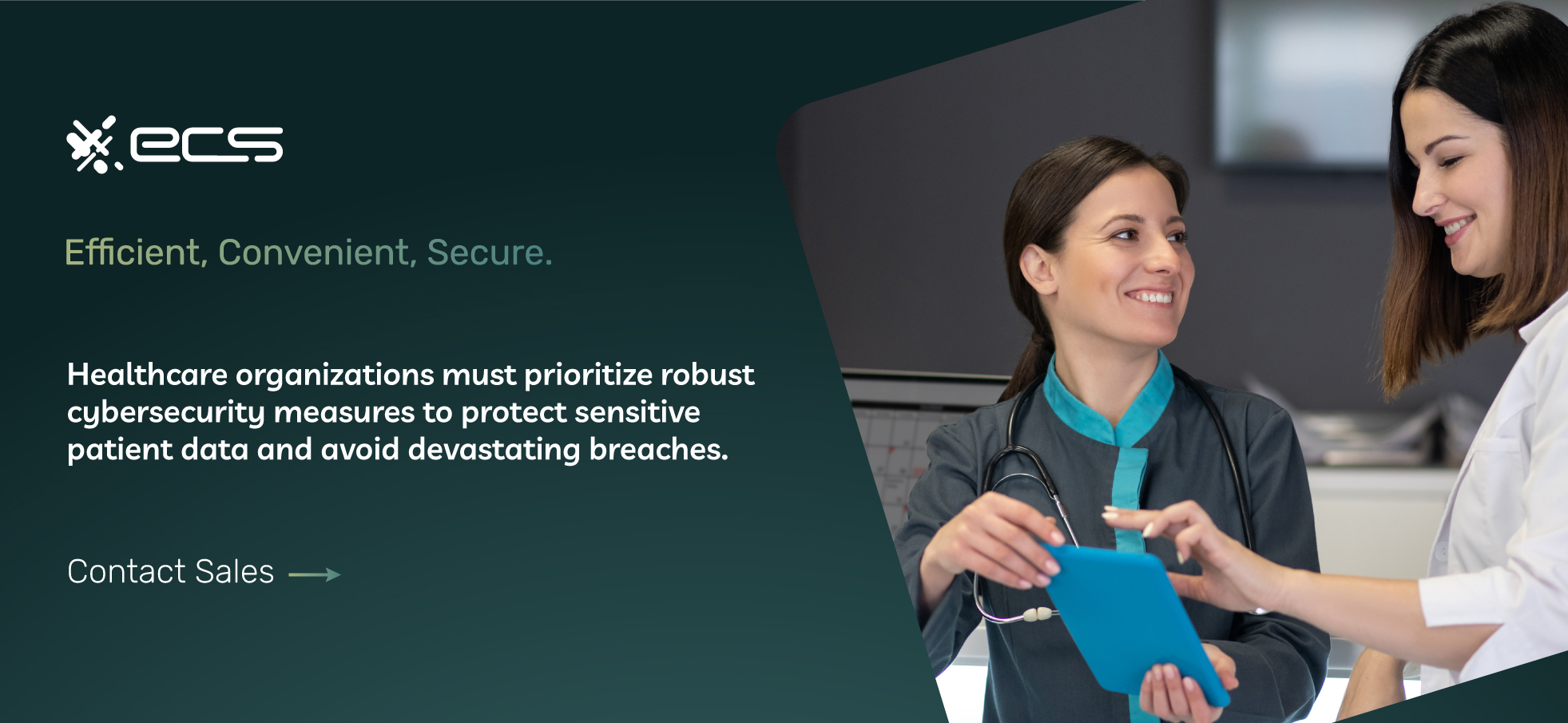
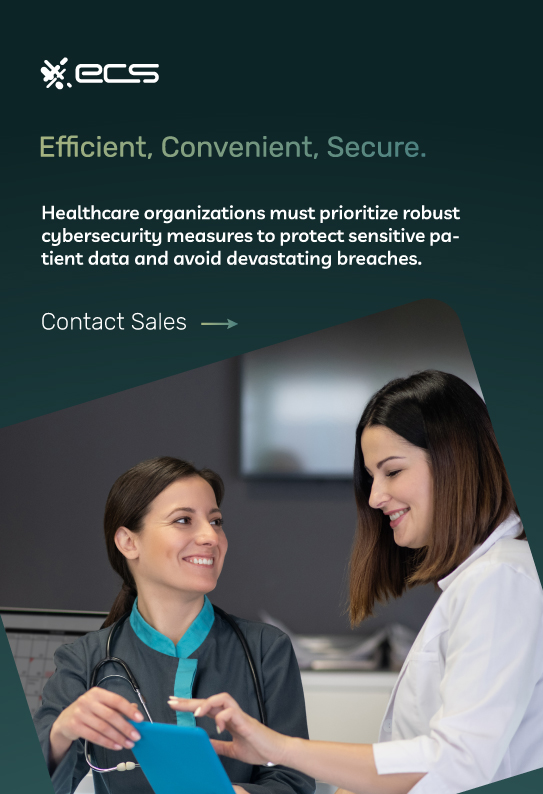
Ensuring HIPAA Compliance Through Your Payment Systems for Healthcare
Payment Data Security Healthcare Solutions
HIPAA sets the standard for protecting sensitive patient data. Any healthcare business with access to protected health information (PHI) must ensure compliance with all required physical, network, and process security measures. The measures provide the framework for healthcare financial transaction regulations. Your organization should have set protocols for managing these areas, including managing payment regulations in healthcare.
The following key areas are critical to maintaining HIPAA and healthcare payment technology compliance for most payment systems involving PHI. Your organization should have set protocols for managing these areas.
Point-to-Point Encryption
Encryption is necessary for PCI DSS compliance and will also help you maintain HIPAA compliance. All payment data should be encrypted using the latest available methods. In most cases, this means using AES encryption that is 128 bits or higher.
This encryption should be used for all connections where credit card payments or billing data travels within your organization or with outside vendors.
AES 128-bit encryption also satisfies the requirements for HIPAA data protection compliance.
Other acceptable encryption methods for PCI DSS or HIPAA include:
- RSA (2048-bits or higher)
- TDES/TDEA (
- DSA/D-H (2048/224 bits or higher)
- ECC (224-bits or higher)
Access Controls
PHI access must be limited to authorized personnel and should involve robust authentication methods. Every member who has access to PHI or payment information should have a unique login that they use when accessing information. Shared logins across employees can create compliance issues when it comes to access controls and should be avoided.
You can ensure proper access control through education and training so that employees are aware that they must log in and log in with their unique ID when accessing billing systems.
For full compliance, access controls must also be applied to physical records and billing information. Physical copies of payment information must be stored in a controlled area that is only accessible by those with authorized access.
Some healthcare businesses still use physical records and payment invoices, but managing these in a compliant way is a challenge. If you’re still managing physical records, you may want to look into digitizing these files to make access control much easier and cost-effective.
Financial Compliance in Healthcare Transactions
Healthcare transactions involve not only patient-related financial data but also regulatory requirements that ensure the secure handling of this data. Maintaining financial compliance in healthcare transactions is crucial to avoid substantial fines and legal penalties associated with non-compliance. By integrating compliant payment systems and adhering to relevant regulations like HIPAA and PCI DSS, healthcare businesses can safeguard sensitive financial information, enhance data security, and protect patients.
Internal Audits
A key aspect of any compliance program is regular internal audits to ensure all protocols are being followed. An audit can also uncover areas to improve so you can prevent compliance issues before they happen.
An audit should include an initial risk assessment to determine where compliance issues may arise. The findings can then be used to enact new processes to address the risks.
Most organizations choose to perform these audits at specific intervals, such as quarterly or annually, depending on the size and scope of each audit.
Managing Cybersecurity Threats In Payment Systems for Healthcare
With the increase of digital payment systems and electronic health records (EHRs), cybercriminals are increasingly targeting healthcare organizations. Understanding and implementing healthcare payment system security requirements is crucial to address this. Recent high-profile cyberattacks on healthcare companies such as UnitedHealth show cybersecurity is more important than ever.
Data protection in healthcare payments is crucial to maintaining patient confidentiality and ensuring compliance with various regulations.
In the healthcare field, many different systems must communicate and share data. These systems create a variety of targets for cybercriminals to use and exploit. If you operate a healthcare business, cybercriminals will likely target your systems at some point.
To help address that threat, you should follow these best practices to avoid costly data breaches and regulatory compliance issues.
Implement Firewalls and Anti-Malware Tools
To protect your systems from attacks, use advanced firewall configurations and regularly updated anti-malware software. Firewalls can be software-based or hardware-based and monitor incoming and outgoing traffic.
Firewalls are crucial for cybersecurity and mandatory for PCI DSS compliance. Any network asset you manage that has access to payment data needs to be protected by a firewall using the appropriate configuration.

Regular Security Updates
A leading cause of cybersecurity attacks on healthcare businesses is out-of-date devices and software, including employee devices and enterprise-level equipment, healthcare software, and servers.
Ensure that your organization has a system for maintaining the latest updates on all devices and software with the latest security patches. If any software or device you use is no longer supported by the vendor and no longer receives security updates, you need to find a replacement.
It’s not uncommon for certain businesses to run legacy software such as Windows 7 on specific machines because the older programs they use only work with those older systems. Even if outdated systems are only used for peripheral operations, they can still allow an attacker to access the system.
To protect your patient data and remain compliant with all regulations, replace outdated software and regularly update your currency systems with the latest security patches.
Incident Response Plans
Every healthcare business needs a cybersecurity incident response plan. This plan outlines what to do if a security or data breach is detected.
The plan’s goal is to provide an immediate response that can help mitigate any damage or compliance issues that may result from the breach. Creating a robust response plan can be rather involved, but there are a few key areas to focus on.
Team Composition
Depending on the size of your organization, you want to create a team leader and then fill out your team with representatives from your IT department, compliance or legal, and human resources.
Responsibilities and Roles
Define clear responsibilities for each team member, ensuring everyone knows their duties during an incident. After-incident reporting often shows that an organization was unaware of what to do during the early stages of a cyberattack or ransomware attack.
Those early stages are critical for protecting other assets and minimizing the damage. In some cases, fast action can even isolate and quarantine an attack before it becomes an operational problem. A dedicated team with clearly defined roles helps your organization respond quickly to any data breach or threat.
Use Monitoring Tools
Today, advanced AI and machine learning monitoring tools can analyze your network activity and spot anomalies or threats before they threaten your patient’s sensitive data.
Most of these monitoring tools are fully automated and provide ongoing, cost-effective protection against high-level threats. With the right configuration, these tools even automatically quarantine suspicious files or traffic without the need for user input.
Reporting Protocols
Create an education program designed to teach every team member how to report any suspicious activity or possible security issue that could jeopardize patient confidentiality. It’s common for employees to notice security breaches relatively early. However, often, they don’t know who to report it to or whether or not it warrants any action.
Your employees are your first line of defense against security issues that threaten your regulatory compliance. Having a reporting procedure in place for employees to follow keeps your risk to a minimum.
Creating A Regulatory Compliance Strategy For Payment Systems for Healthcare
Regulatory compliance can seem like a daunting task, but by breaking it down into segments, you can create a strategy that makes the process much easier.
This section will discuss healthcare payment innovations and compliance strategies for ensuring adherence to regulatory requirements.
Risk Assessment and Management
Risk assessment is your first step. You want to look for areas with the highest risk of compliance problems. Doing this will allow you to focus your resources and energy on the areas that offer the highest returns.
Legal Requirements for Healthcare Payments
Understanding the legal requirements for healthcare payments is crucial for ensuring compliance and avoiding penalties. These requirements often involve stringent data protection standards, accurate record-keeping, and adherence to both federal and state regulations. Non-compliance can lead to significant fines, legal liabilities, and damage to reputation.
Data Breaches
We covered ways to prevent and deal with data breaches earlier, and this is an area you want to consider for your risk assessment. For organizations that have been lax with cybersecurity spending and investment, this may be a high area of risk. If you’ve just completed a cybersecurity evaluation and updated your systems, you can put less emphasis on this area.
Fraud and Abuse
Fraud and abuse of the system can take many forms, from patients to insider risks from employees and personnel. Internal education and fraud management systems can help employees understand the warning signs and risks of fraud or abuse.
You also want to include how employees can report any suspected fraud or abuse within the organization or by vendors. Employees need to know that they are protected when reporting any incident of fraud or abuse. For some organizations, the ability to come forward anonymously may be necessary.
Develop Mitigations Strategies
When you’ve discovered your highest risk areas, you can start to develop your mitigation strategies for each area of concern. Below are the most common mitigation strategies for regulatory compliance and data security
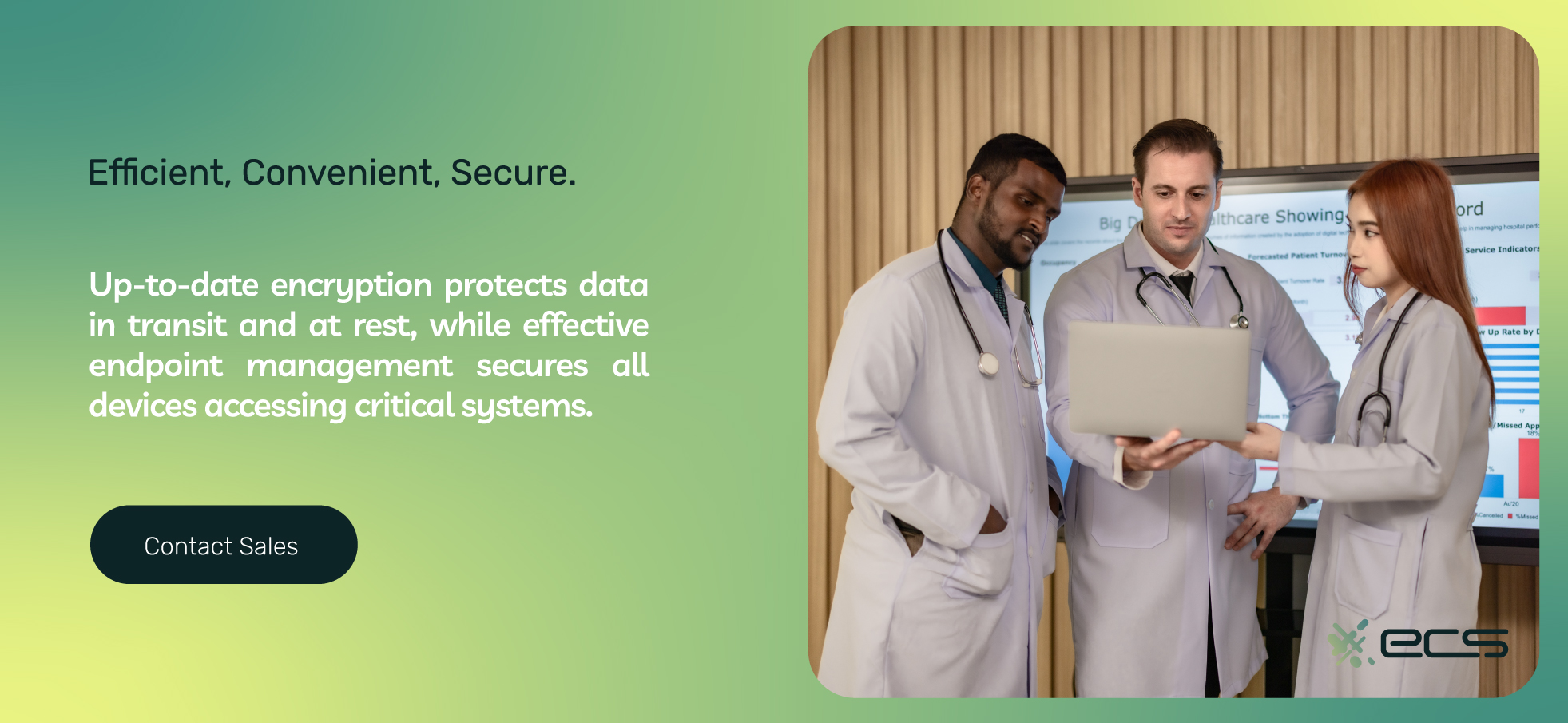
Encryption
Implement strong encryption for stored data and data in transit. Secure access controls and regular security audits safeguard sensitive information. Audit routers and other network devices to ensure they are capable of the most recent encryption technologies.
Older encryption from just a few years ago is not secure. It may cause you to be out of compliance with PCI DSS guidelines and other data security regulations.
Endpoint Security
Endpoint security is important in today’s work environment, where many different devices have access to network assets. Everything from tablets to laptops to smartphones is accessing critical systems, and each one can be a security risk.
Endpoint security helps automate and manage these devices so they are always secure and only access the data they need for the task at hand.
A strong endpoint security plan significantly reduces your risk profile and protects data. Best of all, most of today’s endpoint security tools are highly automated, making them cost-effective.
Employee Training
Training is vital for reducing the risk of compliance issues. Make sure your onboarding includes a discussion about the importance of regulatory compliance when accessing customer payment information and related information.
Existing employees may need assistance and retraining if you’ve recently changed payment systems or added new operational software.
Ongoing Audits
Once you’ve created and implemented your mitigation strategies, you should perform annual audits to address any shortcomings, regulatory changes, or other issues that may require modifying your strategy.
Choosing a Compliant Payment System for Healthcare
Regulatory compliance is easier and less expensive when you start with a payment processor that understands the healthcare industry and related regulation requirements, including healthcare payment processing laws.
Below are key areas to consider when choosing healthcare industry payment solutions:
Compliance Features
Like all your vendors, your payment system should include default compliance features. These include HIPAA and HITECH-compliant data storage, transmission, and access controls. Additionally, investing in compliance software for healthcare payments can streamline the management of regulatory requirements, ensuring all transactions meet the necessary standards.
Integration
Your payment systems should seamlessly integrate with your current EHR and other operational software. Poor integrations can create gaps in security and cause issues with regulatory compliance for healthcare payments.
Your payment processor should be able to analyze your current software and billing infrastructure and provide a payment gateway and solution that offers maximum compatibility and integration potential.
Healthcare Payment Gateways and Compliance
Your payment processor should be able to analyze your current software and billing infrastructure and provide a payment gateway that offers maximum compatibility and integration potential, ensuring compliance with all relevant regulations.
Adherence to PCI DSS Compliance
PCI DSS compliance is necessary to access the wider digital payment network. However, it will also make your HIPAA and HITECH compliance much easier.
PCI DSS has strong guidelines for encryption, data privacy, and network vulnerability testing. Following these guidelines and using a payment processor that takes them seriously will cover most of your healthcare payment system regulations and compliance.
Learn More About Payment Systems for Healthcare
Healthcare businesses face a challenging regulatory landscape, and payment processing can sometimes add another layer of complexity.
Thankfully, the right payment processor can reduce your regulatory burden and help you with compliance. This saves you both time and money and reduces your potential liability related to breaches and other cyberattacks.
Contact ECS Payments today to learn more about our HIPAA-compliant payment processing and solutions for today’s healthcare businesses.
Frequently Asked Questions About Payment Systems for Healthcare
Integrating the right payment systems for healthcare presents challenges. Medical businesses must navigate a complex regulatory structure that involves patient safety, data security, and information management, which can create compliance headaches.
Healthcare businesses must adhere to HIPAA and HITECH regulations enforced by The Department of Health and Human Services (HHS) Office for Civil Rights (OCR) and PCI DSS, enforced by the card brands’ security council when accepting digital payments.
•HIPAA protects patient health information, ensuring that data is kept confidential and secure during electronic transactions.
•The HITECH Act strengthens HIPAA provisions, increases penalties for HIPAA violations, and requires healthcare entities to notify patients of any data breaches within 60 days.
•PCI DSS is a payments industry standard created to ensure secure card transactions.
PCI DSS and HIPAA compliance enhances security, creates trust, improves reputation, and avoids penalties and fines for healthcare businesses that process payments.
